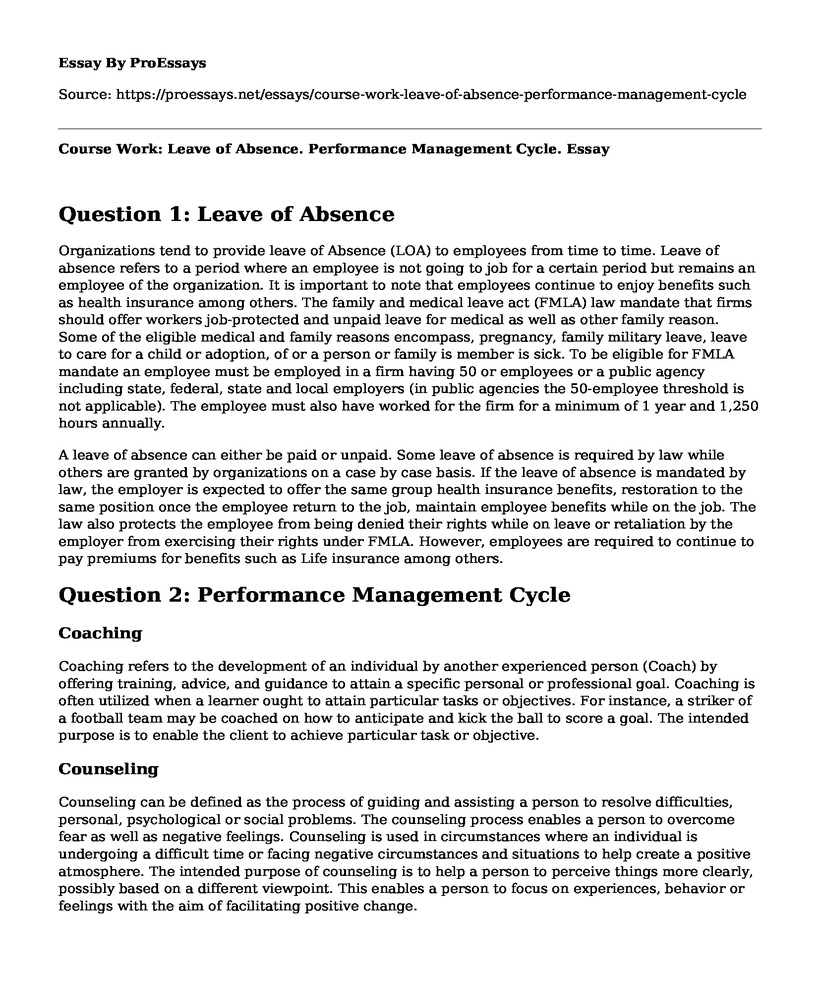Question 1: Leave of Absence
Organizations tend to provide leave of Absence (LOA) to employees from time to time. Leave of absence refers to a period where an employee is not going to job for a certain period but remains an employee of the organization. It is important to note that employees continue to enjoy benefits such as health insurance among others. The family and medical leave act (FMLA) law mandate that firms should offer workers job-protected and unpaid leave for medical as well as other family reason. Some of the eligible medical and family reasons encompass, pregnancy, family military leave, leave to care for a child or adoption, of or a person or family is member is sick. To be eligible for FMLA mandate an employee must be employed in a firm having 50 or employees or a public agency including state, federal, state and local employers (in public agencies the 50-employee threshold is not applicable). The employee must also have worked for the firm for a minimum of 1 year and 1,250 hours annually.
A leave of absence can either be paid or unpaid. Some leave of absence is required by law while others are granted by organizations on a case by case basis. If the leave of absence is mandated by law, the employer is expected to offer the same group health insurance benefits, restoration to the same position once the employee return to the job, maintain employee benefits while on the job. The law also protects the employee from being denied their rights while on leave or retaliation by the employer from exercising their rights under FMLA. However, employees are required to continue to pay premiums for benefits such as Life insurance among others.
Question 2: Performance Management Cycle
Coaching
Coaching refers to the development of an individual by another experienced person (Coach) by offering training, advice, and guidance to attain a specific personal or professional goal. Coaching is often utilized when a learner ought to attain particular tasks or objectives. For instance, a striker of a football team may be coached on how to anticipate and kick the ball to score a goal. The intended purpose is to enable the client to achieve particular task or objective.
Counseling
Counseling can be defined as the process of guiding and assisting a person to resolve difficulties, personal, psychological or social problems. The counseling process enables a person to overcome fear as well as negative feelings. Counseling is used in circumstances where an individual is undergoing a difficult time or facing negative circumstances and situations to help create a positive atmosphere. The intended purpose of counseling is to help a person to perceive things more clearly, possibly based on a different viewpoint. This enables a person to focus on experiences, behavior or feelings with the aim of facilitating positive change.
Corrective Action
Corrective action refers to the process of communicating with a person to improve performance or correct unacceptable behaviour. Corrective action is often used to improve organizations processes and eliminate any undesirable situations. Corrective action is utilized in circumstances of problems so as to prevent the undesirable action from happening again.
Progressive disciplinary plan
Progressive disciplinary plan refers to a plan that an organization use to correct performance problems or unacceptable behaviors. A progressive disciplinary plan is used in situations an employee continues to exhibit unacceptable behavior despite being warned through corrective action. The intended purpose is to bring employee behavior or performance into compliance with the organization's expectations or standards. On the same note, a progressive disciplinary plan is used to ensure that employees who are fired due to poor performance were treated fairly and in agreement with the firms policy.
Termination
Termination is the departure of an employee from a job. Termination can either be voluntary, or an employer can decide to discontinue an employee from working for him. Termination is utilized in a variety of circumstances such as when an employee is not performing, layoff because of economic problems among others. The intended purpose of termination depends on the circumstances. For instance, if an employee is terminated because of poor performance, then the intended purpose is to increase the firms efficiency.
Cite this page
Course Work: Leave of Absence. Performance Management Cycle.. (2021, Apr 19). Retrieved from https://proessays.net/essays/course-work-leave-of-absence-performance-management-cycle
If you are the original author of this essay and no longer wish to have it published on the ProEssays website, please click below to request its removal:
- Operations and Information Management - Essay Example
- Amazon Acquisition of Whole Foods Paper Example
- Perception of Students on Group and Individual Work - Essay Sample
- Essay Example on Casual Employment in Australia
- Essay Sample on Safety and Risk Management & Safety Assurance: Risk Assessment & Control Basis
- Essay Sample on Leadership and Direction in Health Care: Little Success in a Complex Environment
- Essay on Healthcare KPI: Evaluating Quality Care & Enhancing Hospital Performance







